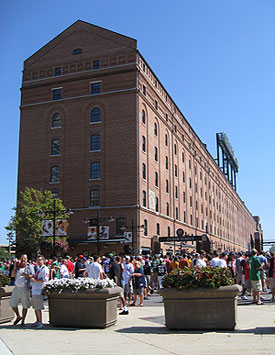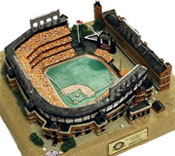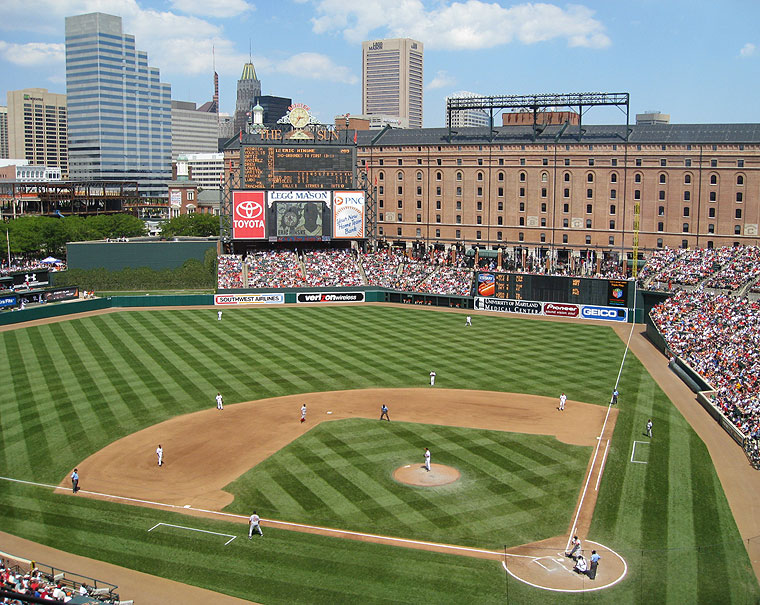
|
After years of adhering to bland utilitarian concepts, a renaissance occurred in ballpark building in Baltimore, Maryland, where the retro-style Oriole Park at Camden Yards opened in 1992.
Constructed for what now seems a paltry sum of just $110 million, Camden Yards helped pioneer many of the modern-day concepts that ballparks at all levels of the sport now embrace, chiefly a traditional, yet original, design that blends into a highly-visible downtown location with a signature feature distinct to the ballpark. It’s been said that the three keys to success in real estate are location, location, and location. That’s where Camden Yards first excels. Built at the southwest corner of downtown Baltimore, the ballpark is about a 15-minute walk to the city’s fabulous Inner Harbor. The skyscrapers that make up the Baltimore skyline hover just beyond the ballpark and are visible to the majority of fans in the three-tiered grandstand. The signature feature of Camden Yards is The Warehouse. No ballpark built in the modern era that Baltimore inspired has been able to incorporate such a striking feature. The beloved B&O Warehouse, which was originally going to be torn down to make way for the ballpark, was preserved and assimilated into the design of Camden Yards. In addition to its aesthetic beauty the Warehouse serves many functional purposes, such as housing the Orioles team shop, and because of its omnipresent size it is visible from anywhere inside of the ballpark. The Eutaw Street entrance (Gate H), roughly behind center field, is where the majority of fans enter the ballpark. The nicely landscaped plaza outside of the Eutaw Street gate has a statue of Baltimore-born Babe Ruth. It’s also where the Orioles honor their legends, which they do by erecting five-foot tall aluminum numbers that correspond to the numbers worn by the five players (Eddie Murray, Jim Palmer, Cal Ripken, Brooks Robinson, Frank Robinson) and one manager (Earl Weaver) who have had their number retired by the team. The extremely popular Eutaw Street promenade runs parallel to the Warehouse and separates it from the seating areas. The 60-foot wide concourse is packed with souvenir and concession stands, including Boog Powell's barbecue stand, and fans walking down the promenade are treated to various historical tidbits. Bronze baseball-shaped plaques are embedded in the concrete walkway, each commemorating a home run that reached the Eutaw Street walkway on the fly. The plaque lists the name of the player, his team, the date the homer was hit, and the distance it traveled Traditional shaped plaques highlight the accomplishments of those inducted into the Orioles Hall of Fame. Further down the walkway are plaques dedicated to the inductees of the Maryland Athletic Hall of Fame, which was established in 1956 to honor Marylanders who excelled in any sport. Baltimore was the birthplace of baseball’s greatest legend, George Herman "Babe" Ruth, and a pair of plaques are dedicated to the Bambino, one of which reads in part: “During the early 1900's, Babe Ruth and his family lived at 406 Conway Street in what is now centerfield of Oriole Park at Camden Yards. Babe's father operated Ruth's Cafe on the ground floor of the residence.” The use of brick is prominent throughout the ballpark. The plaques mentioned above are placed on brick walls opposite the brick warehouse. The wall behind home plate was built with brick, ditto for the staircase in left field. Appropriately, the row houses in the neighborhood surrounding the ballpark are brick structures that blend in with Camden Yard’s outer façade, which…you guessed it…was built with brick. The usage of brick gives the ballpark a traditional feel, as does the other material used in its construction: steel was chosen over concrete. Nearly all ballparks built in the fifty years prior to Camden Yards used concrete, hence the derogatory “concrete donut” moniker those stadiums are now referred to. The quirks of the ballpark also add to its nostalgic appeal. The playing field is asymmetrical and the outfield fence was made of straight wall segments, making Camden Yards the first ballpark since Ebbets Field to lack a uniformly curved outfield wall that stretched from foul pole to foul pole. The batter’s eye has ivy growing on it. On the rare occasion the ivy reaches the top of the backdrop, it is cut back. The multi-level bullpens in left-center are below the tree-lined picnic area that contains the best standing room viewing section in the stadium, although the Eli Jacobs Plaza in right field is the most popular place to hang out. That standing room section is also known as Flag Court, since flags for every American League team - in order of league standing – are located in the plaza. The view there isn’t that good even when you’re able to lean up against the 25 foot high out of town scoreboard, which features an update panel in between each league’s scoreboard. Next to the out of town scoreboard is a field level suite that’s used by members of the Camden Yards grounds crew. Clad in their orange shirts, they sit directly behind the right-center field fence in a section that would otherwise be reserved for high-paying corporate clients. The Orioles were the first, and remain the only, team in the big leagues to allow their rank and file employees to enjoy such great seats, of which there are approximately 30. The ballpark is filled with dark green plastic chairs and the seats in the lower level are padded. Ushers are laid back and unusually friendly. They are happy to take your picture and don’t seem to mind when you “upgrade” your seats. Camden Yards has replaced the Emerson Bromo-Seltzer tower as Baltimore’s most famous architectural landmark, although the famed clock tower visible from the Eutaw Street walkway is used in the logos featured on the main JumboTron scoreboard in right-center. When Camden Yards first opened it was state-of-the-art, but 15 years later half of the ballparks in the Major Leagues are newer and many are better than the original retro ballpark. Camden Yards is still nice, but having seen all the ballparks I can definitely tell it's the oldest of the new breed, and certain things within its confines are outdated. Notable is its lack of an open lower level concourse - meaning you can’t see the playing field from any of the concession stands behind the main grandstand – and the scoreboards all feature dot matrix graphics, which have become outdated since the introduction of LED displays. While some upgrades are needed, at least the Orioles have eschewed the naming rights bonanza that has occurred since the ballpark opened. Oriole Park at Camden Yards is a befitting name for this intimate baseball-only venue. It’s been said many a time that imitation is the highest form of flattery and a creative, fan-friendly regional design is now the blueprint for ballparks. Although technically Buffalo’s Coca-Cola Field started the retro ballpark craze in 1988, it took Camden Yards to burst onto the national scene four years later for a revolution to occur. Because of this ballpark, fans in cities across the United States are better able to enjoy our national pastime. Anyone who loves baseball, and specifically ballparks, owes a debt of gratitude to Camden Yards. It’s fair to say no stadium in history has had a greater impact on its sport. The Warehouse Long and lean, the eight story high Baltimore & Ohio (B&O) Warehouse has become one of the most recognized ballpark landmarks in the world since stadium planners decided to make it a part of the ballpark.
Long and lean, the eight story high Baltimore & Ohio (B&O) Warehouse has become one of the most recognized ballpark landmarks in the world since stadium planners decided to make it a part of the ballpark.
The warehouse was notable before Camden Yards truly made it famous. At 1,016 feet long it has been the longest building on the East Coast since it was completed after seven years of construction in 1905. The warehouse was used by the B&O railroad company, which was headquartered in Baltimore, to store up to 1,000 boxcars full of merchandise. Despite its length, the warehouse is just 51 feet wide. The reason for the narrow width is that B&O had to squeeze their warehouse between railroad yards on the east and S. Eutaw Street on the west. The warehouse was going to be demolished to make way for the ballpark, but a Syracuse University architecture student named Eric Moss designed a plan that incorporated the warehouse into the Camden Yards complex. The team eventually adopted his plan. Restoration of the warehouse involved hand-cleaning each of its 3 million bricks. Removal of a small section of the warehouse was necessary to create the plaza at the Eutaw Street gate entrance. Thanks to the renovations, the warehouse became home to the Orioles’ management offices and a catwalk connects the fourth floor of the warehouse to the ballpark's club level. The warehouse also houses the Orioles' ticket outlets and team shop, plus banquet facilities, sports bars and restaurants, including the exclusive Camden Club, which occupies the top two floors. One of the ballpark's four banks of lights is mounted onto the Warehouse's roof. The B&O Warehouse became the focal point of media attention during Cal Ripken's consecutive games played streak. A banner on the warehouse was updated in the middle of the 5th inning - marking an official game - while he pursued Lou Gehrig's remarkable record. The banners continued to be unfurled up through Ripken's 2,632nd game, which was when his record-breaking streak ended. Standing 439 feet from home plate, the warehouse has only been hit by a batted ball on the fly once. That was in 1993 when Ken Griffey, Jr. hit a 445-foot shot while competing in the Home Run Derby contest during All-Star Game festivities.
Ballpark ConstructionVisions of a baseball-only stadium began with Maryland governor William Donald Schaefer, a former mayor of Baltimore, who was instrumental in getting approval from the Maryland legislature to build a state owned ballpark at the location of a former major rail station known as Camden Yards. Construction on the 85-acre site began in June of 1989 and was completed 33 months later at a cost of $110 million. The ballpark's name generated some initial controversy as Schaefer wanted to name it Camden Yards, while the Orioles owner at the time, Eli Jacobs, preferred Oriole Park. They compromised and the ballpark was officially named Oriole Park at Camden Yards. Camden Yards, as its commonly referred to, broke the mold that was typified by its predecessor, Memorial Stadium, which was a symmetrical multi-purpose stadium situated well outside of downtown Baltimore. Camden Yards turned Kansas City-based architectural firm HOK Sport into a household name, but initially HOK proposed a design that was similar to Chicago's Guaranteed Rate Field, which was the firm's first and forgettable attempt at a MLB facility. Under the advice of architectural consultant Janet Marie Smith, the Orioles (who had the right to approve all aspects of the ballpark's design thanks to a clause in their lease) wisely turned the proposal down and instructed HOK to build a classic ballpark - one inspired by those from the early 20th century. As a result, Crosley Field, Ebbets Field, Fenway Park, Forbes Fields, Shibe Park and Wrigley Field were influential in the design of Camden Yards.
Location and ParkingLocated only two blocks from Babe Ruth’s birthplace in downtown Baltimore, Camden Yards is easy to find. Just follow interstate signs to downtown. The quickest route is to take I-395 until it ends next to the ballpark. M&T Bank Stadium, built in 1998 for the NFL's Baltimore Ravens, is part of the Camden Yards Sports Complex and is next door to the ballpark. There are plenty of parking garages in the city near the ballpark so paying more than $10 is always unnecessary. The ballpark is serviced by public transit. A rail station used by both the Baltimore Light Rail and the MARC commuter rail is located in front of the B&O Warehouse.
Game Day AtmosphereBaltimore is a good baseball city and a fun place to be on game day. Everyone seems to get in the spirit. The Old Otterbein United Methodist Church, the oldest church (1771) in continuous use in the city of Baltimore, is across the street from Camden Yards and features timely baseball verse on its marquee. For example, with the Red Sox in town the church marquee read, “May God bless the Os and maybe the Sox but the Yankees Lord forgive us our thoughts.” Vendors set up shop on sidewalks outside the ballpark, where there's no shortage of crab cakes, hot dogs or sodas. The Eutaw Street promenade is hopping before and during the game. After games throngs of people make the short walk to the city’s Inner Harbor, which is lined with waterfront bars and restaurants.
Camden Yards Footnotes - Facts & Figures
| ||||||||||||||||||||||||||||||||||||||||||||





